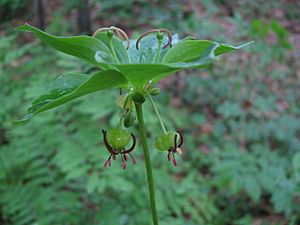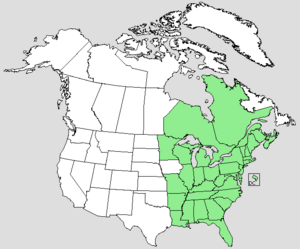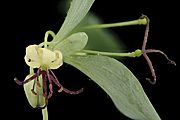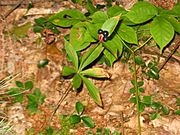Medeola facts for kids
Quick facts for kids Medeola |
|
|---|---|
 |
|
| Flowering | |
| Conservation status | |
| Scientific classification | |
| Genus: |
Medeola
|
| Species: |
virginiana
|
 |
|
| USDA distribution map | |
| Synonyms | |
|
|
Medeola virginiana, often called Indian cucumber or Indian cucumber-root, is a cool plant found in eastern North America. It's part of the lily family, called Liliaceae. This plant is special because it's the only type of plant in its group, known as the genus Medeola. You can usually find it growing in the shady parts of forests. It has rhizomes (underground stems) that you can eat, and they taste a bit like a fresh cucumber!
Contents
What Indian Cucumber Looks Like
Indian cucumber plants have stems that grow up each spring. These stems have two levels, or "tiers," of leaves that grow in a circle, like a whorl.
Leaves and Flowers
The lower tier usually has five to nine leaves. These leaves are shaped like a spear. The top tier has three to five leaves that are more oval-shaped. All the leaves have smooth edges.
Sometimes, a plant might only have one tier of leaves. The second tier grows when the plant is ready to flower. When it has two tiers, the plant can grow up to about 75 cm (30 in) tall.
The flowers appear in late spring. They are a yellowish-green color. After the flowers, the plant grows a dark blue or purple fruit called a berry. This berry is not safe to eat.
How it Grows
Each spring, new Indian cucumber shoots grow from a special underground part. This part is like a small tuber (a swollen underground stem). It also sends out horizontal rhizomes. These rhizomes grow out at an angle and can create a group of new plants that are all genetically the same. This group is called a clonal colony.
Plant Family and History
Scientists group plants into families and genera to understand how they are related. The genus Medeola is currently placed in the lily family, Liliaceae.
Changing Classifications
In the past, Medeola was thought to be closely related to plants like Trillium and Paris. However, scientists now place Trillium and Paris in a different family called Melanthiaceae.
In 1987, a scientist named Armen Takhtajan suggested that Medeola should be in its own family, Medeolaceae. But more recent studies, using things like DNA evidence and how plants look, show that Medeola and another plant called Clintonia are very closely related. Because of this, both Medeola and Clintonia are now grouped together in the lily family (Liliaceae).
Old Names
Some plants that were once called Medeola are now known by different names. For example, some types of Asparagus used to be in the Medeola group:
- Medeola angustifolia is now Asparagus asparagoides
- Medeola asparagoides is also Asparagus asparagoides
- Medeola latifolia is another name for Asparagus asparagoides
- Medeola triphylla is now Asparagus declinatus
Where Indian Cucumber Lives
You can find Medeola virginiana growing across a wide area. It grows from Ontario in Canada, all the way east to Nova Scotia. In the United States, it grows south to Florida and Louisiana.
Habitat
This plant likes to grow in rich, moist forests, thickets, and woodlands. It prefers places with plenty of shade.
Conservation Status
In some places, Indian cucumber is becoming rare. It is listed as an endangered plant in Florida and Illinois. This means it needs special protection to help it survive.
Uses of the Plant
The Indian cucumber plant has a special underground tuber that is crisp and edible. It smells and tastes a lot like a fresh garden cucumber! You can wash it and eat it raw, or you can cook it.
Native American tribes, like the Iroquois, also used this plant. They used it in traditional medicine to help with seizures and as a special remedy for children.
See also
 In Spanish: Medeola para niños
In Spanish: Medeola para niños





